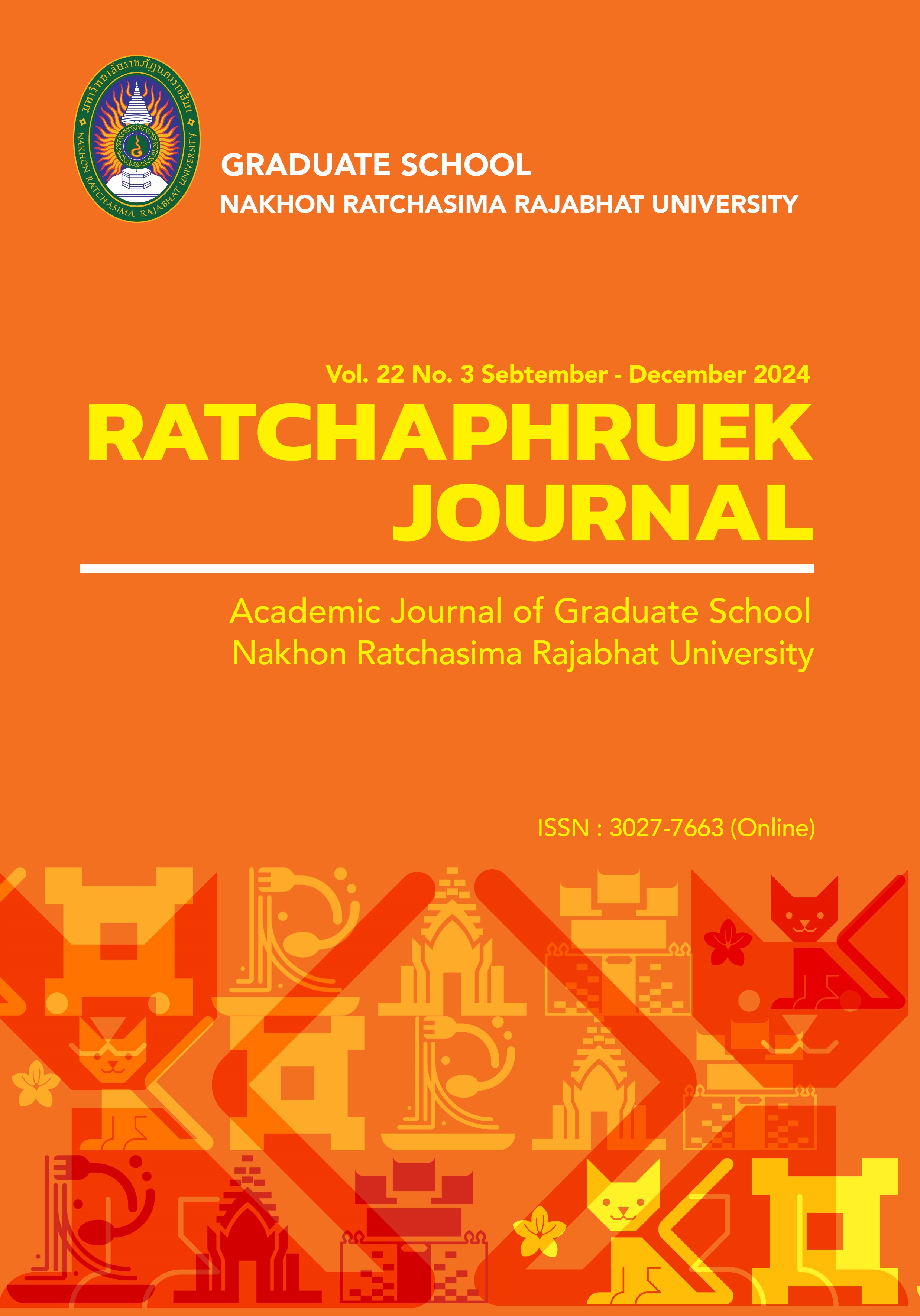การบูรณาการคณิตศาสตร์ร่วมกับเนื้อหาดาราศาสตร์ในวิชาวิทยาศาสตร์ โดยใช้กระบวนการจัดการเรียนรู้แบบ STEM-SML2 แบบมุ่งเป้า
Main Article Content
บทคัดย่อ
การวิจัยนี้มีวัตถุประสงค์เพื่อ 1) พัฒนาการจัดกิจกรรมการจัดการเรียนรู้ STEM-SML2 เนื้อหาดาราศาสตร์ในวิชาวิทยาศาสตร์และคณิตศาสตร์ของนักเรียนชั้นประถมศึกษาปีที่ 4 2) ศึกษาผลสัมฤทธิ์ทางการเรียนจากการจัดกิจกรรมการจัดการเรียนรู้ STEM-SML2 3) ศึกษาความพึงพอใจของนักเรียนต่อการจัดการเรียนการสอนในการจัดการเรียนรู้ STEM-SML2 กลุ่มตัวอย่าง ได้แก่ นักเรียนระดับชั้นประถมศึกษาปีที่ 4 โรงเรียนสาธิตมหาวิทยาลัยราชภัฏเชียงราย ภาคเรียนที่ 2 ปีการศึกษา 2566 จำนวน 1 ห้องเรียน จำนวน 27 คน จากการสุ่มตัวอย่างแบบแบ่งกลุ่ม (Cluster sampling) เครื่องมือที่ใช้ในการวิจัย ได้แก่ เครื่องมือในการทดลอง คือ แผนการจัดการเรียนรู้ STEM-SML2 เครื่องมือในการเก็บรวบรวมข้อมูล คือ แบบทดสอบวัดผลสัมฤทธิ์และแบบสอบถามความพึงพอใจ วิเคราะห์ข้อมูลโดย การหาค่าเฉลี่ย ส่วนเบี่ยงเบนมาตรฐาน และสถิติ t-test แบบ dependent ผลจากการศึกษา พบว่า แผนการจัดการเรียนรู้ STEM-SML2 มีเนื้อหาดาราศาสตร์ในวิชาวิทยาศาสตร์เป็นหลักโดยการบูรณาการ เนื้อหาวิชาคณิตศาสตร์ วิทยาการคำนวณและใช้ภาษาอังกฤษในการสื่อสาร จำนวน 5 แผน เวลา 15 ชั่วโมง คะแนนผลสัมฤทธิ์ทางการเรียนจากการจัดการเรียนรู้แบบ STEM-SML2 หลังเรียน ( = 23.74, S.D. = 2.44) สูงกว่าคะแนนก่อนเรียน (
= 11.82, S.D. = 2.62) อย่างมีนัยสำคัญที่ .05 และนักเรียนมีความพึงพอใจเกี่ยวกับการจัดการเรียนรู้ในภาพรวม (
= 4.35, S.D. = 0.71) อยู่ในระดับมาก
Article Details

อนุญาตภายใต้เงื่อนไข Creative Commons Attribution-NonCommercial-NoDerivatives 4.0 International License.
เอกสารอ้างอิง
กระทรวงศึกษาธิการ. (2565). แผนพัฒนาการศึกษาขั้นพื้นฐาน (พ.ศ. 2566-2570) ของสำนักงานคณะกรรมการการศึกษาขั้นพื้นฐาน. สืบค้นเมื่อ 11 ธันวาคม 2565, จาก http://www. bopp.go.th/?p=2404
จันทร์ดา พิทักษ์สารี. (2547). ผลการจัดการเรียนรู้วิทยาสาสตร์ด้วยวัฎจักรการสืบเสาะหาความรู้ที่ส่งเสริมทักษะการคิดวิจารณญาณต่อความสามารถในการคิดวิจารณญาณและความพึงพอใจต่อการจัดการเรียนรู้ของนักเรียนชั้นมัธยมศึกษาปีที่ 1 (วิทยานิพนธ์มหาบัณฑิต, มหาวิทยาลัยสงขลานครินทร์).
จตุรงค์ ธนะสีลังกูร. (2565). รูปแบบการพัฒนาทักษะการนิเทศภายในแบบมีส่วนร่วมด้วยกระบวนการชุมชนแห่งการเรียนรู้ทางวิชาชีพ: พหุกรณีศึกษาโรงเรียนขนาดเล็ก ในจังหวัดนครราชสีมา. Ratchaphruek Journal, 20(2), น. 69-84.
บุญชม ศรีสะอาด. (2556). การวิจัยเบื้องต้น: ฉบับปรับปรุงใหม่ (พิมพ์ครั้งที่ 9). กรุงเทพฯ: สุวีริยาสาส์น.
พัทธมน นามปวน, นันทรัตน์ เครืออินทร์ และฉัตรชัย เครืออินทร์. (2557). รูปแบบการจัดกิจกรรม การเรียนรู้วิชาวิทยาศาสตร์ เรื่องวัสดุและสมบัติของวัสดุ แบบสะเต็มศึกษา (STEM education) ของนักเรียนชั้นประถมศึกษาปีที่ 5. ใน การประชุมวิชาการระดับชาติ ศึกษาศาสตร์วิจัยครั้งที่ 1 (บทคัดย่อ). สงขลา: มหาวิทยาลัยสงขลานครินทร์.
มณัญญา มานะรัชศักดิ์. (2565). การพัฒนารูปแบบการจัดการเรียนการสอนภาษาอังกฤษตามแนวการสอนภาษาเพื่อการสื่อสารร่วมกับการเรียนรู้แบบร่วมมือเพื่อพัฒนาทักษะการสื่อสารและความมั่นใจในการใช้ภาษาอังกฤษ สำหรับนักเรียนชั้นประถมศึกษา (วิทยานิพนธ์มหาบัณฑิต, มหาวิทยาลัยศิลปากร).
มาเรียม นิลพันธุ์. (2558). วิธีวิจัยทางการศึกษา (พิมพ์ครั้งที่ 8). นครปฐม: โรงพิมพ์มหาวิทยาลัยศิลปากร.
สุภัคชา มลวัง และสกนธ์ชัย ชะนูนันท์. (2566). การพัฒนาความสามารถในการสื่อสารวิทยาศาสตร์ด้วยการจัดการเรียนรู้โดยใช้ปรากฏการณ์เป็นฐานร่วมกับกลวิธีการคิดเป็นภาพ เรื่อง สารในชีวิตประจำวันของนักเรียนชั้นประถมศึกษาปีที่ 5. Journal of Roi Kaensarn Acadami, 8(1), น. 119-136.
Alyona, O. S. (2021). Basic principles of communicative grammar during english lessons at primary school. Science and Education Scientific Journal, 2(2), pp. 365-369.
Chung, C. J., Cartwright, C. & Cole, M. (2014). Assessing the impact of an autonomous robotics competition for STEM education. Journal of STEM Education, 15(2), pp. 24-29.
Clinch, J. J. & Keselman, H. J. (1982). Parametric alternatives to the analysis of variance. Journal of Educational Statistics, 7(3), pp. 207-214.
Cochran, W. G. & Cox, G. M. (1976). Experimental design. New York: John Wiley and Sons.
Kolodner, J. L., Camp, P. J., Crismond, C. D., Fasse, B., Gray, J., Holbrook, J., Puntambekar, S. & Ryan, M. (2003). Problem-based learning meets case-based reasoning in the middle-school science classroom: Putting learning by designTM into practice. The Journal of the Learning Sciences, 12(4), pp. 495-547.
Posner, M. I. (2008). Measuring alertness. Annals of the New York Academy of the New York Academy of Sciences, 1129(1), pp. 193-199.
Quinn, H. R. (2012). A framework for K-12 science education. Washington: National Academies Press.
Vasquez, J. A., Sneider, C. & Comer, M. (2013). STEM Lesson essentials, grades 3-8: Integrating science, technology, engineering, and mathematics. Portsmouth, NH: Heinemann.
Walubengo, W. W., Kyalo, D. N. & Mulwa, A. S. (2019). Analytical review of application of problem tree analysis as a project design tool for enhancing performance of community based in Kenya. European Journal of Business and Management Research, 4(6), pp. 1-7.


